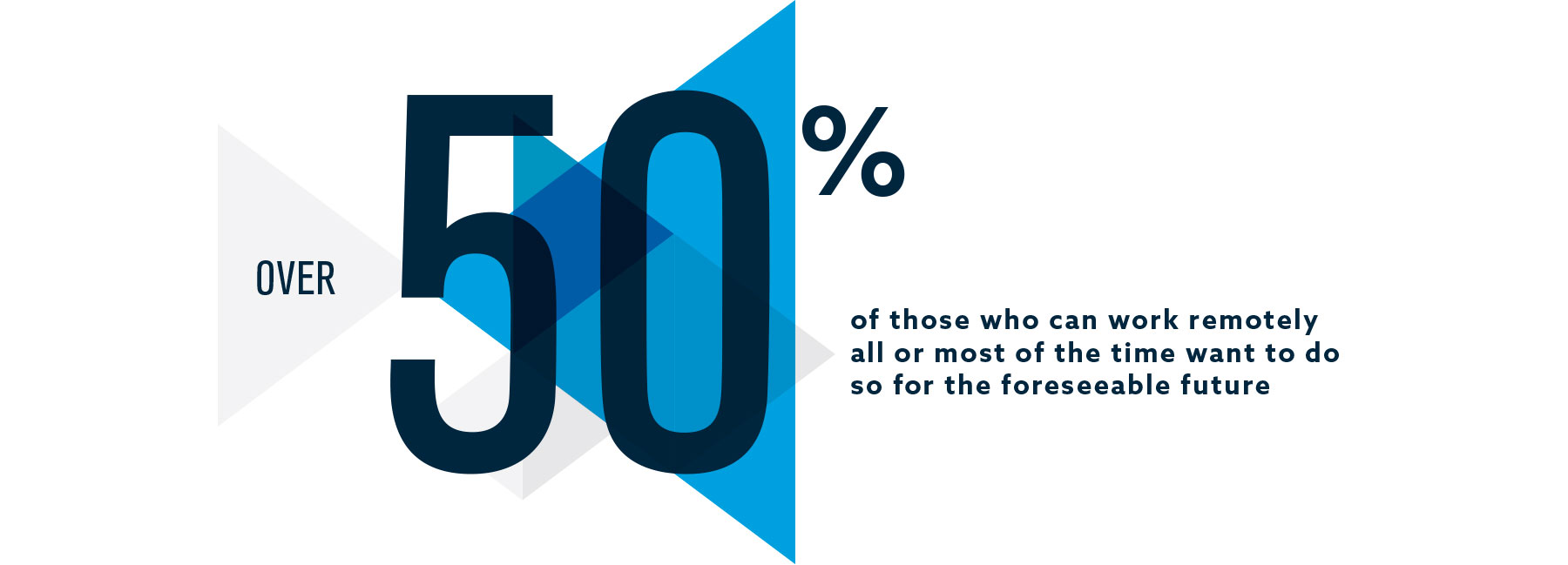CONTRIBUTORS
MATTHEW COHEN
senior vice president, client services, Sedgwick
MICHELLE HAY
global chief people officer, Sedgwick
The past few years have been marked by unprecedented upheaval in the workforce. Employees and organizations the world over are reconsidering where and when work gets done. The pandemic, combined with the rising cost of living, has led many to examine their personal priorities and career goals — sparking a large-scale reshuffling of talent known as the Great Resignation.
Further, baby boomers are transitioning into retirement, leaving behind significant gaps in institutional knowledge and job skills. Members of Generation Z are eagerly entering the workforce but have different career expectations than their predecessors.
It is against this complex backdrop that organizations are engaged in a fierce war for talent.
Culture as a differentiator
In efforts to reduce attrition and attract new talent, employers are looking to use the strength of their organizational cultures to set themselves apart from the competition. Here, we highlight four qualities today’s workforce seeks in an employer and how you can leverage the latest trends to enhance these aspects of your organizational culture, making it more attractive to current and prospective employees.

#1: Meaning and belonging
With modern workers devoting so much time to their careers, they increasingly look to their jobs to provide them with a sense of purpose. Additionally, employees want to feel part of something larger than themselves and that their work contributes to making a meaningful difference in the world. This is especially true for younger members of the workforce, who tend to view work as not “just a job” but an extension of their personal identity.
To address the sense of purpose that workers crave, many job duties have been reframed in terms of their meaning and significance, rather than their mechanics. Postings for jobs in all sorts of fields — not just the traditional helping professions — now include words like “empathy” and “caring.” For employers to successful hire and retain people to whom these values are important, they must continually work to provide caring employee and customer experiences, rather than merely paying lip service in their recruiting efforts.
Companies are putting greater emphasis on environmental, social and governance (ESG) as they strive to be responsible corporate citizens and the kind of organizations with which employees are proud to be associated. Efforts in this area focus on sustainability; diversity, equity and inclusion (DEI); strategic corporate giving; business ethics and other initiatives. In particular, embedding DEI into organizational practices helps employees feel a sense of belonging and comfort in knowing their full, authentic selves will be accepted and respected at work.
New research shows that Generation Z and millennial employee loyalty is directly related to organizational commitment to making a positive impact on society. Some employers are using volunteerism to demonstrate social responsibility and foster connections to the communities in which they operate. Giving employees paid time off to volunteer for a nonprofit, incorporating service projects into team meetings, and arranging for employee groups to assist at volunteer sites are just a few of the ways employers can reinforce their values while giving back; these approaches also give employees a greater sense of meaning and purpose in their connection to work.
#2: Appreciation and recognition
When committing to an organization, people want to feel confident their hard work won’t go unnoticed. They crave employers that value them as individuals and the unique traits and skills they bring to the team. Amid today’s war for talent, recognizing employees isn’t merely a nice thing to do; it’s an organizational performance imperative.
Traditionally, employee recognition has focused on monetary rewards. Cash bonuses and other financial incentives have long been tied to employee performance. Those companies that offer performance bonuses to the third-party examiners and adjusters who service their programs well consistently view it as a win-win. The incentives demonstrate that these professionals are viewed as valuable partners who are appreciated for the support they provide; they also motivate high engagement and advocacy and reduce organizations’ total cost of risk.
While it is certainly appropriate to compensate people for outstanding performance and to share organizational success with those who made that success possible, meaningful recognition must be about more than dollars and cents. According to a recent study, recognition has the greatest impact when it fulfills employees’ needs and expectations and is authentic, equitable, personalized and embedded in the organizational culture. The research found that employees who have good workplace recognition experiences are three times more likely to feel strong loyalty to the organization, while those who report low-quality or infrequent recognition are at high risk for leaving.
Among today’s workforce, recognition is less about receiving individual accolades and more about opportunities for connection. Employees want acknowledgement from senior leadership, kudos from their direct managers and avenues for recognizing peers for a job well done. Additionally, they are looking for workplace recognition to mirror their online social interactions. Organizations are using intranets and other digital platforms to showcase recognized employees, giving the workforce visibility into who was recognized and the opportunity to post messages of congratulations. The social aspects of recognition have taken on greater significance, now that many employees are dispersed and/or working remotely.
Team recognition is growing in popularity as a way for workgroups to celebrate their collective contributions, rather than highlighting one person’s achievements above the rest. This can take the form of special group meals, spirit days, friendly competitions, social outings and themed events that demonstrate appreciation and foster camaraderie and belonging.
#3: High level of performance
Most people — top achievers in particular — approach each day with the sincere desire to do good work and perform well at their jobs. Developing a high-performance organizational culture is critical to helping employees stay motivated and deliver excellence.
A key element of driving performance is goal setting. Establishing individual and team goals at the outset of each year gives employees ambitions for which to strive. Regularly marking progress made toward those goals helps employees and teams stay on track and better understand how their efforts contribute to the organization’s overall success. It’s important to consider how goals are measured; for instance, an abstract goal like improving advocacy in workers’ compensation must be broken down into elements that are quantifiable, such as reducing the number of injured workers seeking legal representation and (safely) increasing return to work rates.
Supporting an atmosphere of learning is another critical piece of high-performance cultures. Ongoing development opportunities enable employees to keep their skills sharp, gain new proficiencies, and enjoy personal and professional growth. When employers invest in employee development, people feel a stronger sense of belonging, well-being and loyalty. A 2022 workforce survey indicates that more than half the workforce is likely to leave their current employment if they do not receive ample and fulfilling professional development. Corporate universities, tuition assistance benefits, mentorship programs and access to other resources are regularly touted as attraction and retention tools.
Despite the current talent shortage, employees who are underperforming should not simply be overlooked on the presumption that no one better is available to replace them. Doing so threatens to have a detrimental effect on team morale and motivation. In most cases, employees can be coached to better performance, given additional skills training, evaluated for necessary accommodations, or transferred to a better-fitting role.

#4: Flexibility
When millions of people transitioned to working from home in 2020 to curb the spread of COVID-19, many discovered they enjoyed the benefits of remote work. Eliminating the commute to the office from their daily routines gave them more time to focus on other priorities, like caregiving, exercise and personal errands, or to get more work accomplished. Those in jobs with flexible timing found themselves thriving by working at the time of day (or night) when they perform best. Many in today’s workforce want to feel a sense of empowerment — that their employer trusts them to get their work done well and on-time without someone standing over their shoulder. The evolution and popularity of flexible work ushered in by the pandemic has provided the balance and autonomy they’ve craved.
Most employers presumed their workforces would return to the office once the peak risks of COVID had subsided. Having people in the office, they reasoned, would ensure productivity levels were maintained, enable managers to better monitor their teams, and help employees feel connected to their peers and the organization.
However, employers have seen how challenging it is today to retain employees and attract new talent without offering some level of flexibility. A 2020 Pew Research Center survey showed that over 50% of those who can work remotely all or most of the time want to do so for the foreseeable future — and that number is likely even higher today. Another study found that about half of all workers are likely to seek other job opportunities if not given flexibility in their work schedules and locales. The trends of the Great Resignation have shown this to be true, with less flexible employers and industries struggling to find and keep talent.
Organizations that wish to remain competitive in meeting current workforce expectations should continue to evolve their cultures to embrace greater flexibility. Making those adjustments requires some innovation and planning, but employers stand to gain a lot from the investment. Eliminating geographic requirements from job positions, for example, widely expands talent pools to include candidates in multiple locations and those with varying transportation access and physical mobility. Additionally, employers can save on costs associated with office space, relocations and more. Study results and data from our book of business demonstrate that flexible work options reduce absences from work. Perhaps most importantly, flexibility can improve employee satisfaction and well-being without sacrificing productivity, leading to improved talent attraction and retention.
Of course, not every type of job lends itself to flex time or working from home. There are other flexible work models that employers can consider, such as split shifts (with an extended break in the middle of the day) or compressed schedules of fewer but longer days (such as four 10-hour days per week). While it may not be feasible for employers to offer all of these options to everyone, many can implement at least one to most employees, giving people greater balance and autonomy without jeopardizing operational effectiveness.
Putting people first
These are just four of the many facets of organizational culture that affect the employee experience and, in turn, whether people choose to stay with or join an organization. An overarching factor, which we would be remiss not to address here, is front-line leadership. People managers play a critical role in how all aspects of culture are operationalized. Organizational initiatives cannot succeed without the positive support and reinforcement of people managers. One employee’s experience may dramatically differ from another’s, depending on the leadership style of their managers and how those managers put the culture into practice each day. Employers looking to build stronger organizational cultures will benefit from further developing and educating their people managers.
Here at Sedgwick, we have three guiding principles to align our collective efforts and thought processes: the colleague experience, the customer experience and profitable growth. It’s quite intentional that colleague experience comes first on that list. Sedgwick has long believed that if we take proper care of our colleagues, they will take good care of our customers, and the rest will fall into place for the business.
The disruptive workforce trends we’ve seen in the past few years make this philosophy more relevant than ever. If employers want to attract and retain top talent in today’s competitive environment, they must keep people at the center of their decision-making and work to foster cultures that can support employees during tumultuous times.
